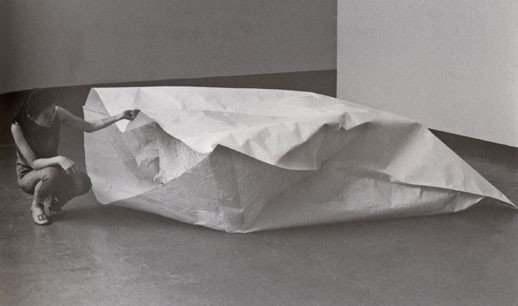Zung Inspires | Mono-ha
Mono-ha, which means "School of Things," was a Japanese art movement that emerged in the late 1960s and lasted until the mid-1970s. This movement marked a significant departure from traditional Japanese art forms and had a profound impact on the international art world. Three of the most prominent artists of the Mono-ha movement whose works are fundamental to the history of modern art, meditated, refined, and infinitely thought-provoking are Koji Enokura, Lee Ufan, and Nobuo Sekine.
The origination story of the art movement Mono-ha starts with Sekine’s 'Phase-Mother Earth' in Kobe in October 1968. At the 1st Suma Park Contemporary Sculpture Biennale, Sekine, with the help of two other Mono-ha artists, Susumu Koshimizu and Katsuro Yoshida, dug a cylindrical hole in the park and next to the hole compacted the unearthed dirt into the exact same shape: a cylinder 8.5 feet tall, 7 feet wide.
Nobuo Sekine, 'Phase - Mother Earth' (1968)
As one critic put it, “When Sekine finished the work, however, something unexpected happened: he was simply stunned by the sheer power of the “thing” (mono) before him. The reality of it overwhelmed whatever concepts he originally had in mind.”
Koji Enokura, 'Wall' (1971)
Koji Enokura, ‘Intervention (Story - No. 30)’ (1991)
Koji Enokura's use of discarded materials, such as old tires and concrete blocks, was reminiscent of the assemblage art style popularized by artists like Robert Rauschenberg and Jasper Johns. Enokura's focus on the interaction between the materials and the environment tied into the larger modernist tradition of challenging the traditional boundaries between art and life.
Lee Ufan's work was influenced by the minimalism movement, which was characterized by the use of simple, industrial materials and a focus on the physical properties of the materials themselves. Like minimalists such as Donald Judd and Dan Flavin, Ufan sought to bring attention to the materials themselves and to explore the relationship between objects and space.
Nobuo Sekine's use of industrial materials, such as steel plates and concrete, tied into the larger trend of post-minimalism and the rejection of the strict minimalism of the 1960s. Sekine's work was more focused on the process of creation and the relationship between the materials and the viewer, reflecting the broader trend in modern art of exploring the role of the spectator in the creative process.
The Mono-ha movement and the works of artists like Koji Enokura, Lee Ufan, and Nobuo Sekine tie into the larger history of modern art by challenging traditional art forms and exploring the relationship between objects, space, and the viewer. These artists' works continue to be influential and important examples of the experimental spirit of modern art. Other notable artists within this school of thought include Katsuro Yoshida, Susumu Koshimizu, Kishio Suga, Noboru Takayama and Katsuhiko Narita.
Photos via Pace Gallery, Gladstone Gallery, Nobuo Sekine, Tokyo Art Beat






